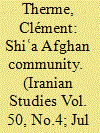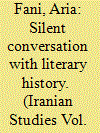| Srl | Item |
| 1 |
ID:
154103


|
|
|
|
|
| Summary/Abstract |
Private universities are a rapidly expanding form of education in Iran, and increasingly include Islam and the social sciences alongside the hard sciences too. What implications does the privatization of religious and social scientific knowledge have for the Islamic Republic? Scholarship has so far responded by looking at the ways in which the Iranian authoritarian state has monopolized religion, repressed the social sciences and hollowed out student activism. Complicating these arguments, this article provides a historical and institutional comparison of higher education in Iran in order to look at the evolving degree of autonomy of academic institutions and the ability of actors that operate within them to contribute to critical debate, social activism and novel discourse. The article proposes that while state universities and Islamic Azad suffer from politicization and control, a small set of privately owned “Islamic” universities is using its elite connections, financial independence and socio-pedagogical ties to the seminary and modern academia to secure enhanced levels of free debate and independent thinking.
|
|
|
|
|
|
|
|
|
|
|
|
|
|
|
|
| 2 |
ID:
154099


|
|
|
|
|
| Summary/Abstract |
The article examines the contents and the historical background of five early specimens of diplomatic correspondence on the Pashtun tribal territories. Written in Persian by the Khatak chief Afzal Khān (d. circa 1740/41) these letters supplement the author’s Pashto account of his political conflict with the Khatak spiritual leaders, the sheikhs, in 1724. While in the letters the tribal chief appealed for judicial settlement of the conflict via legal procedure in the Sharia Court of Peshawar, in verbal negotiations he sought extrajudicial administrative arbitration or tribal practices of reconciliation according to the Pashtun customary law. The article conttrunains new materials for the historiography of Pashtun tribes and for comparative study of conflict patterns in Muslim tribal societies.
|
|
|
|
|
|
|
|
|
|
|
|
|
|
|
|
| 3 |
ID:
154104


|
|
|
|
|
| Summary/Abstract |
This paper probes the relationship between visual representations and visitation practices at Pasargadae, a UNESCO World Heritage site in southern Iran. Presenting a systematic analysis of publicly available online images of Pasargadae, the paper examines the complex relationship between the place and its visual representations. Through analysis, the paper elaborates on a sense of intimacy that, while grounding Pasargadae, is also a potential common ground in pre-Islamic heritage in which the Iranian state and society could at once meet and contest versions of identity. Examining this relationship facilitates reflections into both heritage and the peculiarities of its visual representation in the Iranian context.
|
|
|
|
|
|
|
|
|
|
|
|
|
|
|
|
| 4 |
ID:
154102


|
|
|
|
|
| Summary/Abstract |
This paper incorporates a study of “re-ghettoization” among the Armenian Christians of the Islamic Republic of Iran. It focuses on how legal marginalization has led to the emergence of an entirely separate existence from the Muslim majority in Tehran among Armenians born after the revolution. By focusing on the spatial and social divisions of the hayashatner (Armenian neighborhoods) and the “social” ghetto of the Ararat Compound, this article addresses the question: what are the social implications for religious discrimination in the Muslim Middle East? This paper is based on three extensive blocks of fieldwork carried out in Iran from 2010 to 2015.
|
|
|
|
|
|
|
|
|
|
|
|
|
|
|
|
| 5 |
ID:
154100


|
|
|
|
|
| Summary/Abstract |
This article aims to present a political analysis of the relationship between the Shiʿa community in Afghanistan and the new political system that emerged after the US military intervention of 2001. In light of the sectarian conflicts in the greater Middle East and the connection between South West Asia and the Syrian war since 2011, this article illustrates the limits of the social empowerment of the Shiʿa communities in Afghanistan. The article outlines the internal religious scene and the connections between āyatollāhs (marājeʿ), mainly from Iran or Iraq, and Afghan Shiʿite believers. It also examines how the Afghan Shiʿite community differs from those of Iran and Iraq.
|
|
|
|
|
|
|
|
|
|
|
|
|
|
|
|
| 6 |
ID:
154101


|
|
|
|
|
| Summary/Abstract |
Episodic approaches may point in the direction of general trends by examining the ideological presuppositions of dominant literary discourses. However, they necessarily reduce the aesthetic complexity of literary movements and fail to critically consider poets whose vision may not directly speak to common literary trends. Poets such as Bizhan Jalāli (d. 1999) have been rendered standalone figures whose visions of poetic modernism are understood only in the context of their “non-adherence” to the dominant literary discourse of their time or are overlooked altogether. This essay examines how the literary life and reception of Bizhan Jalāli intersect with the intellectual and aesthetic underpinnings of committed circles in the 1960s and 1970s. The twists and turns of Jalāli’s poetics do not speak directly but rather laterally to committed articulations of modernism. The article returns Jalāli to his literary milieu by analyzing the way his work has been received by poets, anthologists and critics. As the contours of literary commitment drastically change in the 1980s and 1990s, another image of Jalāli emerges: once marginalized for his “non-commitment,” he is championed as an “apolitical” poet.
|
|
|
|
|
|
|
|
|
|
|
|
|
|
|
|